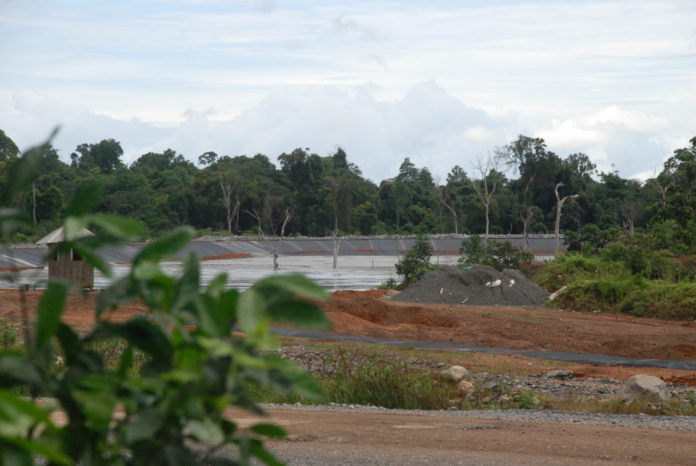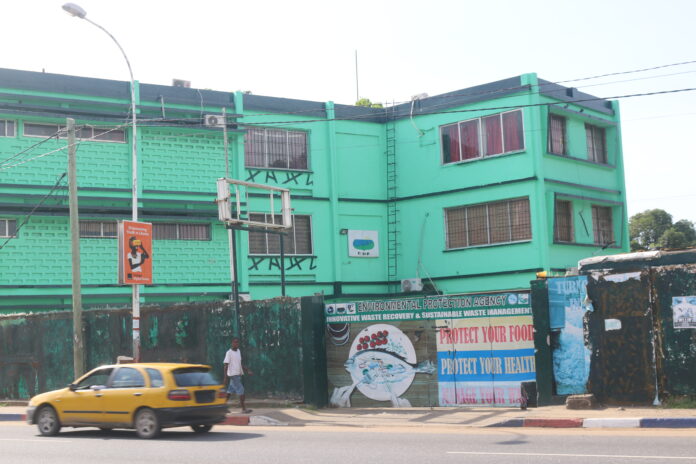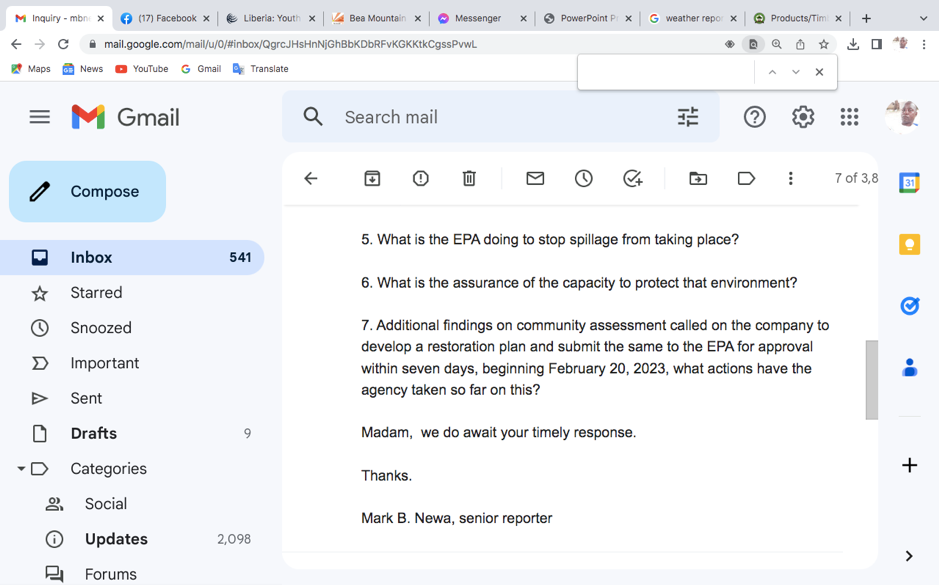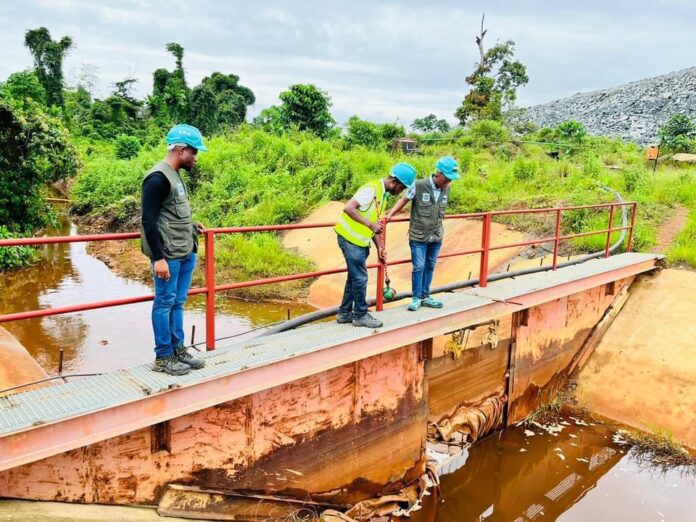Top: The pollution-prone Bea Mountain Mining Corporation’s chemical waste plant. The DayLight/Varney Kamara
By Mark Newa and James Harding Giahyue
- The Environmental Protection Agency (EPA) misled the public last year when it said a second investigation found chemicals that spilled into waterways from a Bea Mountain Mining Corporation facility were below approved levels.
- EPA’s Executive Director Wilson Tarpeh further deceived the public, saying that rainwater had washed the leaked cyanide, arsenic and copper away
- The EPA has not been transparent in handling the Bea Mountain pollution saga in Grand Cape Mount County. It buried the report last month on its website almost a year after the spillage
- There is no public record Bea Mountain paid a fine for last year’s spill, which undermines the ‘polluter pay’ principle of the environmental law of Liberia
- EPA’s arguments against misleading the public, hiding pollution reports and not punishing Bea Mountain are inconsistent with the law and not based on facts
MONROVIA – In June last year, the Environmental Protection Agency (EPA) of Liberia announced that Bea Mountain Mining Corporation, a Turkish-owned mining company, polluted water sources in Kinjor, Grand Cape Mount County.
“The analysis results showed higher than [the] permissible level of free cyanide (with source from the BMMC tailing storage facility),” a statement from the agency said on August 8 last year.
“The presence of excess cyanide led to the contamination of the water sources and that the situation has severely disrupted and injured the livelihood of the communities that depend on those water resources…,” it added. The statement followed weeks of a public frenzy after dead fish and a dog’s body made rounds on Facebook.
But in a miraculous reversal of the report, the EPA cleared the company some two months later. To the ire of residents and the outcry of the public, it said in a statement, “All facilities tested were appreciably below the permissible level set up by the EPA.”
Addressing a news conference in early August that year, The Executive Director of the agency Professor Wilson Tarpeh explained the shocking reversal. Tarpeh said the agency had only set a 30-day period for waterfronts in the area to be safe for use.
“The limit, even though it was above, but that limit was not by itself sufficient to cause distress to the aquatic species,” Tarpeh told a news conference a day after the statement. “The cyanide level—the level of pollution—has been cured by natural occurrence: rain. Rainwater washed all of that away the fishes are about to come back.”
But the actual report on the spillage the statement and Tarpeh referenced shows the EPA deceived the public. EPA investigators had found the chemicals that leaked from the Bea Mountain facility were well above the approved limits over a month after the incident, according to the report. Chemicals in several samples collected from different locations exceeded the approved limits set by the World Health Organization and the International Finance Corporation (IFC). (The IFC, the World Bank’s private lending entity, invested £5.3 million into Bea Mountain’s Cape Mount project.)

Water samples from the area of the spillage show cyanide, iron, arsenic, and copper had seeped into the Marvoe Creek and the Mafa River. The chemicals, used to mine gold, can make people sick and are capable of killing them.
Tests also prove that dissolved oxygen (DO), which supports aquatic life, was below the permissible level, according to the report. Mining waste can cause low concentrations of DO and kill fish, which take in the substance directly through their gills into their bloodstreams.
One sample shows mercury—used to recover gold nuggets can cause a horde of health problems and death—above the required level. Investigators attributed it to likely artisanal-mining activities, the report points out. In total, three out of five laboratory tests show illegal levels of chemicals.
The report says the water quality had made an “appreciable improvement” by July. However, the EPA focused on that development and left out the report’s actual findings.
Former Minister of Justice Benedict Sannoh, the villagers’ lawyer, made a similar point, despite the EPA’s dishonesty over the July 2022 report. “The EPA report does not suggest and cannot be construed to mean that contamination of the Marvoe did not take place,” Sannoh said in a statement. “Cyanide is not a naturally occurring element of waters and creeks.”
In an interview with The DayLight last Wednesday, EPA Executive Director Tarpeh continued with the same deceptive narrative, focusing on the dilution of the chemicals rather than the pollution.
“In May, that’s the rainy season. There is a chemical spill here each year. it rained plenty, you expect the chemicals to be there? Tarpeh asked rhetorically.
“The water washed the chemicals away. What happened in May, had it happened in the dry season, it would have had more impact.”
Lack of Transparency
The EPA has not been transparent over the spillage, which paralyzed the livelihood of some 350 people in affected communities. It did not inform the public about the full scale of the pollution. The July remains buried on the agency’s website. You have to conduct an advanced search on the website to find the report, though earlier documents are in plain sight.
It was unclear when EPA actually published the reports. For the last two or three years or so, EPA’s website does not show dates of publications. The agency’s webmasters make that determination. That empowers webmasters to manipulate publications’ dates, according to an information technology expert who does not want to be named. The DayLight’s analysis of the website shows that both the May and July reports were published on April 5, 2023, nearly a year after the incident.
Ngumbu, who investigated the spill, blamed technical issues for the website’s dateless publications. He said the website was being constructed.
Tarpeh added that the EPA delayed publishing the report because it had to complete its reporting process before publication.
“Our report room is very huge, it is a new phenomenon that we’ve introduced for reporting,” Tarpeh said. Here, we have to be exhaustive. “If I came to your company and I found that something is wrong, I am the regulator and you say no I do not agree, we base on the principle of due process.”
The excuse does not hold. EPA was very open with the May report on the spill. It issued several statements last year—the first just days after news of the spill—and called a press conference. Even appeared before the Legislature on the matter.
The agency’s actions to keep the July report quiet were almost palpable. Tarpeh had dedicated nearly all of the time to a press conference a day after the misleading statement that cleared the company to wetlands. He spent around two and a half minutes on the spillage, though it was the most trending environmental issue then. An attempt by The DayLight to pose a question on the spill was denied.
Noteworthy, investigators had recommended a press conference particularly on the matter in the presence of company representatives, according to the July 2022 report. A report on another spillage this year, published at the same time as the May and July 2022 reports, suggests the EPA did not share last year’s findings with affected communities.
The EPA has continued its concealment trend this year after chemicals leaked again from the same facility in February. Meanwhile, 100 people have left the Jikando, the epicenter of the pollution, that report says. The current spill remained unreported until late last month when The DayLight broke the news. EPA had likely published it at the same time as the reports on last year’s spillage, over a month after the incident had occurred.
More on Bea Mountain Spills
The EPA refuted The DayLight’s story on this year’s spill and its disguise of the new development as a “diabolical lie.” It has, however, remained quiet on the new incident.
“We are [a] scientific and [a] regulatory agency. What we do has legal implications. We can sue and can be sued,” said Dobayou, who imposed an illegally huge fine against Bea Mountain in 2018.
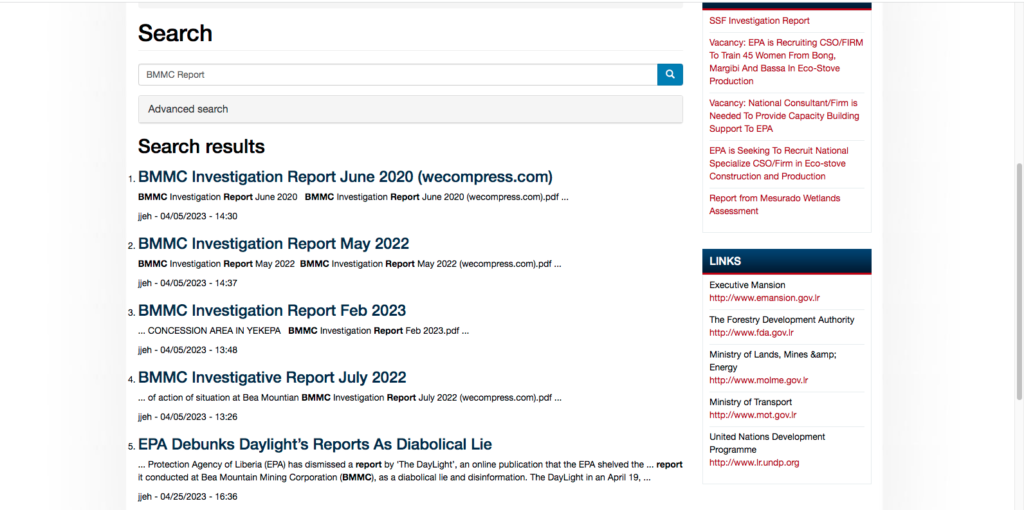
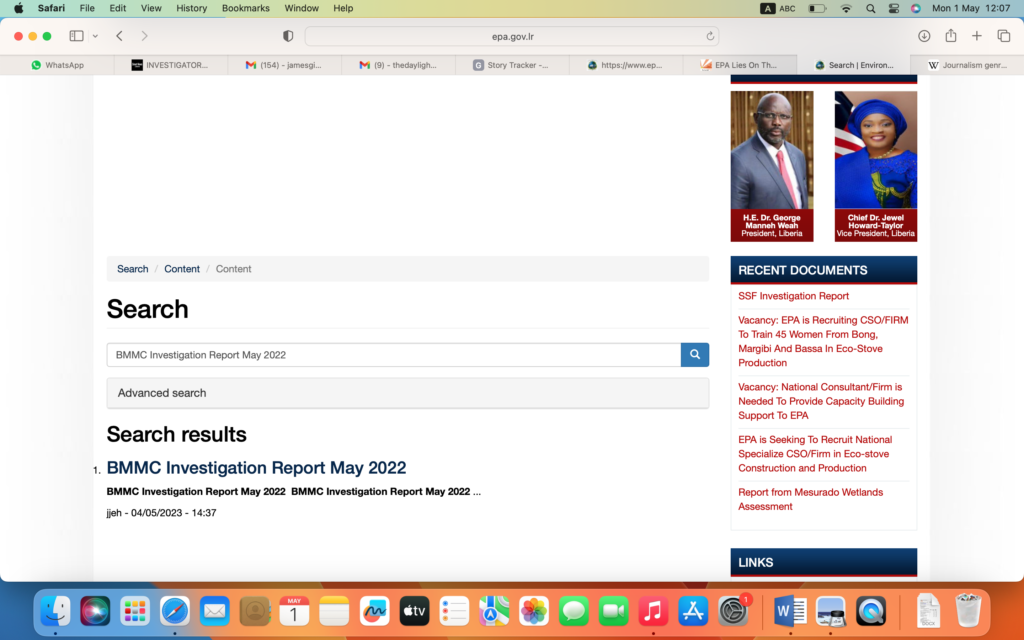
Concealing information violates the public participation portion of the Environmental Protection and Management Law. The particular provision mandates the EPA to “ensure maximum participation by the Liberian people in the management and decision-making processes of the environment and natural resources.”
No Punishment for Bea Mountain
There is no evidence the EPA imposed a fine against Bea Mountain for last year’s spillage, one of at least five in the last decade.
The report of this year’s spillage called on EPA to impose a fine against the company for violating the law and the terms of its waste plant permit. It found that Bea Mountain did not implement all the recommendations of the May 2022 report but did not specify. Like this year’s report, the two reports from last year had urged the EPA to fine the company.
A 2020 EPA investigation of Bea Mountain’s controversial waste plant found the company operated an open wastewater facility, rather than the approved closed one. It said the company conducted construction at the plant without authorization. It further said Bea Mountain denied EPA investigators access to its laboratory and company documents. Investigators found the water from a 25-centimeter metal pipe, which emptied into a wetland in the area, contained an excess of the deadly cyanide, copper, and iron. The report also called for fines at the time. Two years earlier in 2018, the EPA fined Bea Mountain US$99,999 for the same offense. EPA ordered the company to pay to the Liberia Revenue Authority (LRA) “within 72 hours as of the receipt of the notice of fine.”
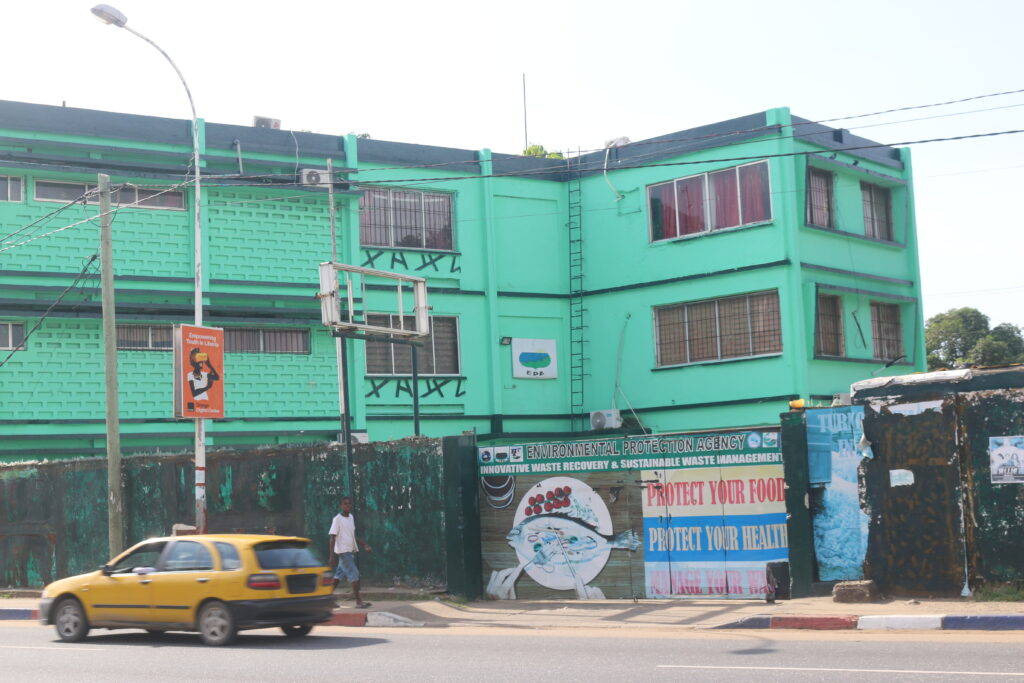
Asked why EPA did not fine Bea Mountain, Tarpeh did not confirm or deny. “We don’t collect the money,” he said, dodging the question. Normally, if a company pays a fine to the LRA, it must present a receipt to the institution that imposed the fine. Tarpeh ignored that fact.
“Go to the LRA,” he added.
LRA records show that Bea Mountain has never paid an EPA-imposed fine in its 14 years of operations in Liberia. All but one of the company’s fines have been customs-related, imposed by the LRA itself. The other fine is also a solitary US$100 just the same time as last year’s spill the LRA calls “other legal fines and penalties.”
Such impunity undermines the “polluter pay” principle of the environmental law the EPA was established to implement. Based on the law, Bea Mountain should have paid up to a 10-year prison term or a fine not more than US$25,000, or both fine and imprisonment.
Bea Mountain, which denied any wrongdoing regarding the spillage last year, did not reply to queries for this story. The Turkish-owned company signed a 25-year agreement with the Liberian government on July 29, 2009. It is owned by Turkish billionaire Mehmet Nazif Günal, also the owner of MNG Gold, which also has a 25-year agreement with Liberia.
Bea Mountain’s history of polluting water sources in the Gola Konneh District dates back to 2015, according to media reports. Then the next year, an accident released chemical waste into nearby waterfronts.
After those spills, villagers filed a complaint with two European banks that finance Bea Mountain’s goldmine. Bea Mountain said the spill in 2016 was the result of “an extremely rare and unusual weather event that led to the overflowing” of its waste facility, according to a report by the banks.
Funding for the story was provided by the Green Livelihood Alliance (GLA 2.0) through the Sustainable Development Institute (SDI). The DayLight maintained complete editorial independence over its content.

